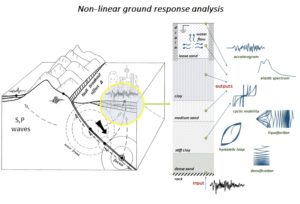Macroelement modelling of liquefiable soils
As the contribution of liquefaction to the observed damage in recent earthquakes is  acknowledged, this project aims to address the need to develop a numerical algorithm executing non-linear ground response analysis of layered sites, capable of reproducing liquefaction phenomena, by considering the simultaneous dissipation of the excess pore water pressure through soil grains. Τhe wave propagation algorithm is based on the plasticity constitutive model for sand, Ta-Ger, expressed in a one dimensional p-q space form, which exhibits remarkable versatility in representing complex patterns of sand cyclic behavior, such as stiffness decay and decrease in strength due to build-up of pore-water pressure. The model is reformulated from its initial form to provide a unified framework of analysis for both drained and undrained loading conditions, and can be applied in sand and clay. Its calibration is based on shear modulus reduction and damping curves for drained loading conditions and liquefaction resistance curves for undrained conditions. The model is implemented through an explicit finite difference algorithm into an in-house computer code which performs integration of the wave equations to obtain the non-linear response of the soil. The accuracy of the algorithm is verified through comparison with analytical solutions and then validated against experimental data from two centrifuge experiments. Consequently, the recorded seismic ground response of the Port Island array from Kobe 1995 earthquake is used as a benchmark for testing the validity of model predictions. The model is then applied to estimate the elastic response spectra at the surface of soil profiles with liquefiable layers (ground type S2) as per EC8:2004. The investigation study involves the ground response analysis of diverse soil profiles, all including a liquefiable zone, excited with a suite of earthquake motions at their base. From the results, an idealized response spectrum is deduced in terms of the design spectrum parameters S, η, ΤΒ and TC. Finally, the numerical algorithm is deployed in order to model the dissipation of excess pore water pressure through drains, that are used to mitigate the liquefaction effects. The differential equation of soil consolidation is reformulated to account for the horizontal axisymmetric water flow. The model is verified though comparison with 3D numerical analyses in FLAC3D, of a thin sand layer enhanced with vertical soil drains and set between clayey layers to establish purely horizontal flow towards the drains.
acknowledged, this project aims to address the need to develop a numerical algorithm executing non-linear ground response analysis of layered sites, capable of reproducing liquefaction phenomena, by considering the simultaneous dissipation of the excess pore water pressure through soil grains. Τhe wave propagation algorithm is based on the plasticity constitutive model for sand, Ta-Ger, expressed in a one dimensional p-q space form, which exhibits remarkable versatility in representing complex patterns of sand cyclic behavior, such as stiffness decay and decrease in strength due to build-up of pore-water pressure. The model is reformulated from its initial form to provide a unified framework of analysis for both drained and undrained loading conditions, and can be applied in sand and clay. Its calibration is based on shear modulus reduction and damping curves for drained loading conditions and liquefaction resistance curves for undrained conditions. The model is implemented through an explicit finite difference algorithm into an in-house computer code which performs integration of the wave equations to obtain the non-linear response of the soil. The accuracy of the algorithm is verified through comparison with analytical solutions and then validated against experimental data from two centrifuge experiments. Consequently, the recorded seismic ground response of the Port Island array from Kobe 1995 earthquake is used as a benchmark for testing the validity of model predictions. The model is then applied to estimate the elastic response spectra at the surface of soil profiles with liquefiable layers (ground type S2) as per EC8:2004. The investigation study involves the ground response analysis of diverse soil profiles, all including a liquefiable zone, excited with a suite of earthquake motions at their base. From the results, an idealized response spectrum is deduced in terms of the design spectrum parameters S, η, ΤΒ and TC. Finally, the numerical algorithm is deployed in order to model the dissipation of excess pore water pressure through drains, that are used to mitigate the liquefaction effects. The differential equation of soil consolidation is reformulated to account for the horizontal axisymmetric water flow. The model is verified though comparison with 3D numerical analyses in FLAC3D, of a thin sand layer enhanced with vertical soil drains and set between clayey layers to establish purely horizontal flow towards the drains.
